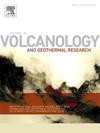Chemical and isotopic characterization of groundwater and thermal waters from the Campi Flegrei caldera (southern Italy)
IF 2.4
3区 地球科学
Q2 GEOSCIENCES, MULTIDISCIPLINARY
Journal of Volcanology and Geothermal Research
Pub Date : 2025-01-23
DOI:10.1016/j.jvolgeores.2025.108280
引用次数: 0
Abstract
We report here on the results of an extensive hydrogeochemical survey of the chemical and isotopic composition of thermal groundwater in the Campi Flegrei caldera (CFc), a restless volcanic system in the Campania Volcanic Province of Southern Italy. Our hydrogeochemical study, based on the collection of 114 groundwater samples, is the first comprehensive one since uplift, seismicity and degassing resumed in 2005, continuing today at accelerating rate. We use our results to characterize the processes that control the wide diversity of groundwater composition observed. We identify a set of key source processes governing the composition of the CFc thermal waters: i) the infiltration of meteoric water, responsible for the formation of diluted cold groundwater having bicarbonate as the prevalent anion (fresh waters), ii) mixing, upon downward infiltration in the aquifer(s), with high-temperature hydrothermal reservoir brines of probable marine origin (chloride waters), iii) the dissolution of a CO2-He rich magmatic-hydrothermal gas, with isotopic signature (respectively δ13C ∼ −1 ‰ vs. PDB and 3He/4He ∼ 3Ra, where Ra is the atmospheric He isotope ratio) similar to the Solfatara hydrothermal gases, generating bicarbonate-rich groundwater; (iv) near-surface dilution by hot condensates, formed by partial condensation of H2S-rich Solfatara like hydrothermal steam, generating sulphate-rich steam heated waters. In near-surface environments, upward migrating groundwater also degases, releasing poorly soluble gas compounds (He, Ar, N2, CH4) and becoming enriched in more soluble CO2. The above processes can work in concert, but each dominates in specific regions of the hydrothermal system, hence causing the extreme spatial diversity of water chemistry observed within the caldera. Our conceptual model for the processes acting within the thermal groundwater system will be crucial to interpreting any temporal change in groundwater chemistry observed in the installed permanent (instrumental) groundwater-monitoring network, which is critically needed for improving geochemical volcano monitoring during current acceleration of the unrest.
意大利南部Campi Flegrei火山口地下水和热水的化学和同位素特征
我们在这里报告了对Campi Flegrei火山口(CFc)热地下水化学和同位素组成的广泛水文地球化学调查的结果,Campi Flegrei火山口是意大利南部坎帕尼亚火山省的一个不稳定的火山系统。我们的水文地球化学研究基于114个地下水样本的收集,这是自2005年恢复隆起、地震活动和脱气以来的第一个综合研究,并在今天加速进行。我们使用我们的结果来描述控制所观察到的地下水成分多样性的过程。我们确定了一套控制含氯氟烃热水组成的关键源过程:i)大气水的渗透,形成了以碳酸氢盐为主要阴离子的稀释冷地下水(淡水);ii)含水层向下渗透后,与可能来自海洋的高温热液储层盐水(氯化物水)混合;iii)富含CO2-He的岩浆热液气体的溶解,其同位素特征分别为δ13C ~−1‰vs. PDB和3He/4He ~ 3Ra。其中Ra为大气He同位素比值)类似于Solfatara热液气体,生成富碳酸氢盐地下水;(iv)热冷凝物近地表稀释,由富硫化氢的Solfatara如热液蒸汽部分冷凝形成,生成富硫酸盐的蒸汽加热水。在近地表环境中,向上迁移的地下水也会脱气,释放出难溶性气体化合物(He、Ar、N2、CH4),并富集更易溶的CO2。上述过程可以协同工作,但每个过程在热液系统的特定区域占主导地位,因此造成了火山口内观察到的水化学的极端空间多样性。我们对热地下水系统中作用过程的概念模型对于解释在已安装的永久性(仪器)地下水监测网络中观测到的地下水化学的任何时间变化至关重要,这对于在当前动荡加速期间改善地球化学火山监测是至关重要的。
本文章由计算机程序翻译,如有差异,请以英文原文为准。
求助全文
约1分钟内获得全文
求助全文
来源期刊
CiteScore
5.90
自引率
13.80%
发文量
183
审稿时长
19.7 weeks
期刊介绍:
An international research journal with focus on volcanic and geothermal processes and their impact on the environment and society.
Submission of papers covering the following aspects of volcanology and geothermal research are encouraged:
(1) Geological aspects of volcanic systems: volcano stratigraphy, structure and tectonic influence; eruptive history; evolution of volcanic landforms; eruption style and progress; dispersal patterns of lava and ash; analysis of real-time eruption observations.
(2) Geochemical and petrological aspects of volcanic rocks: magma genesis and evolution; crystallization; volatile compositions, solubility, and degassing; volcanic petrography and textural analysis.
(3) Hydrology, geochemistry and measurement of volcanic and hydrothermal fluids: volcanic gas emissions; fumaroles and springs; crater lakes; hydrothermal mineralization.
(4) Geophysical aspects of volcanic systems: physical properties of volcanic rocks and magmas; heat flow studies; volcano seismology, geodesy and remote sensing.
(5) Computational modeling and experimental simulation of magmatic and hydrothermal processes: eruption dynamics; magma transport and storage; plume dynamics and ash dispersal; lava flow dynamics; hydrothermal fluid flow; thermodynamics of aqueous fluids and melts.
(6) Volcano hazard and risk research: hazard zonation methodology, development of forecasting tools; assessment techniques for vulnerability and impact.

 求助内容:
求助内容: 应助结果提醒方式:
应助结果提醒方式:


